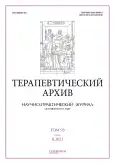A medicinal liver injury with an immunomodulatory drug of natural origin. Case report
- Authors: Reznik E.V.1,2, Yudin D.V.1, Gudilova Y.Y.3, Baikova I.E.1, Karmanova S.E.1, Nikitin I.G.1,4
-
Affiliations:
- Pirogov Russian National Research Medical University
- Buyanov City Clinical Hospital
- International Medical Center ON CLINIC
- National Medical Research Center “Treatment and Rehabilitation Center”
- Issue: Vol 93, No 8 (2021)
- Pages: 932-935
- Section: Case reports
- URL: https://journals.rcsi.science/0040-3660/article/view/79545
- DOI: https://doi.org/10.26442/00403660.2021.08.200975
- ID: 79545
Cite item
Full Text
Abstract
As practice shows, there are many alternative drugs that cause drug damage to the liver. A case of medicinal damage to the liver with an immunomodulatory herbal preparation Immunostimulating collection, which included St. John's wort, Elecampane, Kopeichnik, Echinacea, Licorice, Rosehip, is presented. A 39-year-old patient came to the clinic with complaints of yellowing of the skin, whites of the eyes, heaviness in the epigastrium after eating, lightening of feces, dark urine, sour taste in the mouth, bloating, pruritus, decreased appetite, pronounced general weakness, drowsiness 10 days after you start taking herbal immunostimulant. The diagnosis of drug damage to the liver was made taking into account the history and laboratory parameters, since the patient had negative markers of viral hepatitis and increasing of biochemical blood tests: alanine transferase up to 2800 U/l (norm up to 32 U/L), aspartate transferase up to 1776 U/l (norm up to 31 U/l), total bilirubin up to 577 U/l (norm up to 21 U/l), direct bilirubin up to 116 U/l (norm up to 4.3 U/l), alkaline phosphatase up to 112 U/l (norm up to 98 U/l). After the withdrawal of the immunomodulator and the appointment of therapy, including diet, enzyme replacement therapy, drugs clinical and laboratory manifestations of liver drug damage completely disappeared. This confirms the leading role of the immunoactive drug, which the patient took in the toxic effect on the liver.
Full Text
##article.viewOnOriginalSite##About the authors
Elena V. Reznik
Pirogov Russian National Research Medical University; Buyanov City Clinical Hospital
Author for correspondence.
Email: elenaresnik@gmail.com
ORCID iD: 0000-0001-7479-418X
доктор медицинских наук, заведующий кафедрой пропедевтики внутренних болезней лечебного факультета
Russian Federation, Moscow; MoscowDenis V. Yudin
Pirogov Russian National Research Medical University
Email: elenaresnik@gmail.com
ORCID iD: 0000-0002-3963-1999
студент лечебного факультета
Russian Federation, MoscowYulia Y. Gudilova
International Medical Center ON CLINIC
Email: elenaresnik@gmail.com
врач-гастроэнтеролог
Russian Federation, MoscowIrina E. Baikova
Pirogov Russian National Research Medical University
Email: elenaresnik@gmail.com
кандидат медицинских наук, доцент кафедры госпитальной терапии №2 лечебного факультета
Russian Federation, MoscowSofya E. Karmanova
Pirogov Russian National Research Medical University
Email: elenaresnik@gmail.com
ORCID iD: 0000-0001-6988-7373
студентка педиатрического факультета
Russian Federation, MoscowIgor G. Nikitin
Pirogov Russian National Research Medical University; National Medical Research Center “Treatment and Rehabilitation Center”
Email: elenaresnik@gmail.com
ORCID iD: 0000-0003-1699-0881
доктор медицинских наук, профессор, заведующий кафедрой госпитальной терапии
Russian Federation, Moscow; MoscowReferences
- Yu YC, Mao YM, Chen CW, et al. CSH guidelines for the diagnosis and treatment of drug-induced liver injury. Hepatol Int. 2017;11:221-41. doi: 10.1007/s12072-017-9793-2
- Галимова С.Ф. Лекарственные поражения печени (ч. 1). Трансплантология. 2011;1:13-21 [Galimova SF. Medicinal liver damage (part 1). Transplantology. 2011;1:13-21 (in Russian)].
- Полунина Т.Е., Маев И.В. Лекарственный гепатит. Гастроэнтерология. Consilium Medicum. 2008;1:3-10 [Polunina TE, Maev IV. Medicinal hepatitis. Gastroenterology. Consilium Medicum. 2008;1:3-10 (in Russian)].
- Lee WM. Etiologies of acute liver failure. Semin Liver Dis. 2008;28(2):142-52. doi: 10.1055/s-2008-1073114
- Tajiri K, Shimizu Y. Practical guidelines for diagnosis and early management of drug-induced liver injury. World J Gastroenterol. 2008;14(44):6774-85. doi: 10.3748/wjg.14.6774
- Ивашкин В.Т., Барановский А.Ю., Райхельсон К.Л., и др. Лекарственные поражения печени (клинические рекомендации для врачей). Рос. журн. гастроэнтерологии, гепатологии, колопроктологии. 2019;29(1):85-115 [Ivashkin VT, Baranovsky AYu, Raikhelson KL, et al. Drug-Induced Liver Injuries (Clinical Guidelines for Physicians). Russian Journal of Gastroenterology, Hepatology, Coloproctology. 2019;29(1):85-115 (in Russian)]. doi: 10.22416/1382-4376-2019-29-1-101-131
- Rawlins M, Thompson U. Mechanisms of adverse drug reactions. In: Textbook of adverse drug reactions. Ed. D Davies. N.Y.: Oxford University Press, 1991; p. 18-45; Reporting adverse drug reactions definitions of terms and criteria for their use. Geneva: CIOMS, 1999.
- Maddrey WC, Boitnott JK. Drug-induced chronic liver disease. Gastroenterology. 1977;72(6):1348-53.
- Aithal GP, Watkins PB, Andrade R, et al. Review. Case definition and phenotype standardization in drug-in-duced liver injury. Clin Pharmacol Ther. 2011;89(6):806-15.doi: 10.1038/clpt.2011.58
- Fisher K, Vuppalanchi R, Saxena R. Drug-Induced Liver Injury. Arch Pathol Lab Med. 2015;139(7):876-87. doi: 10.5858/arpa.2014-0214-RA
- Andrade RJ. EASL Clinical Practice Guidelines: Drug-induced liver injury. J Hepatol. 2019;70:40. doi: 10.1016/j.jhep.2019.02.014.
Supplementary files







